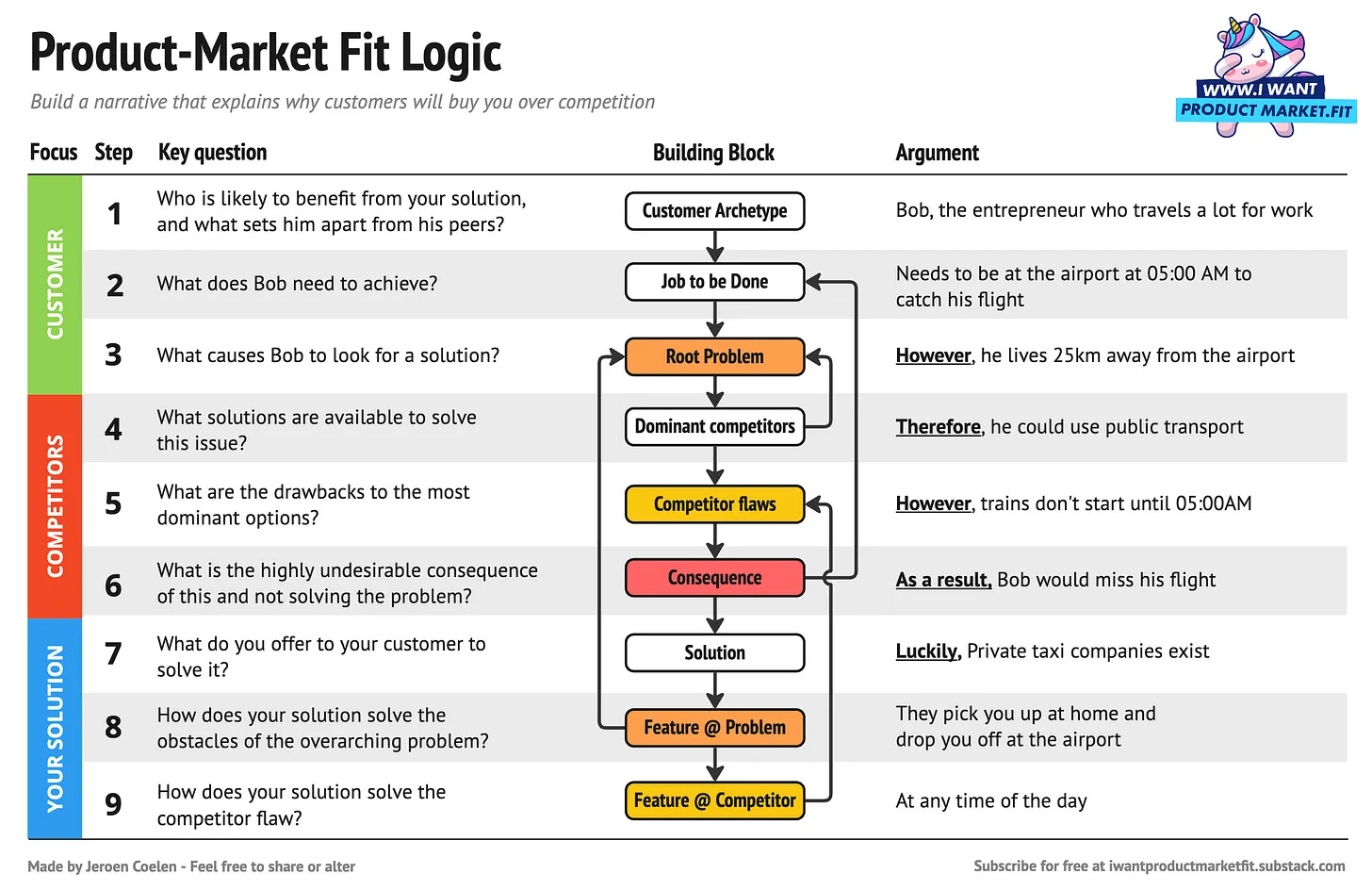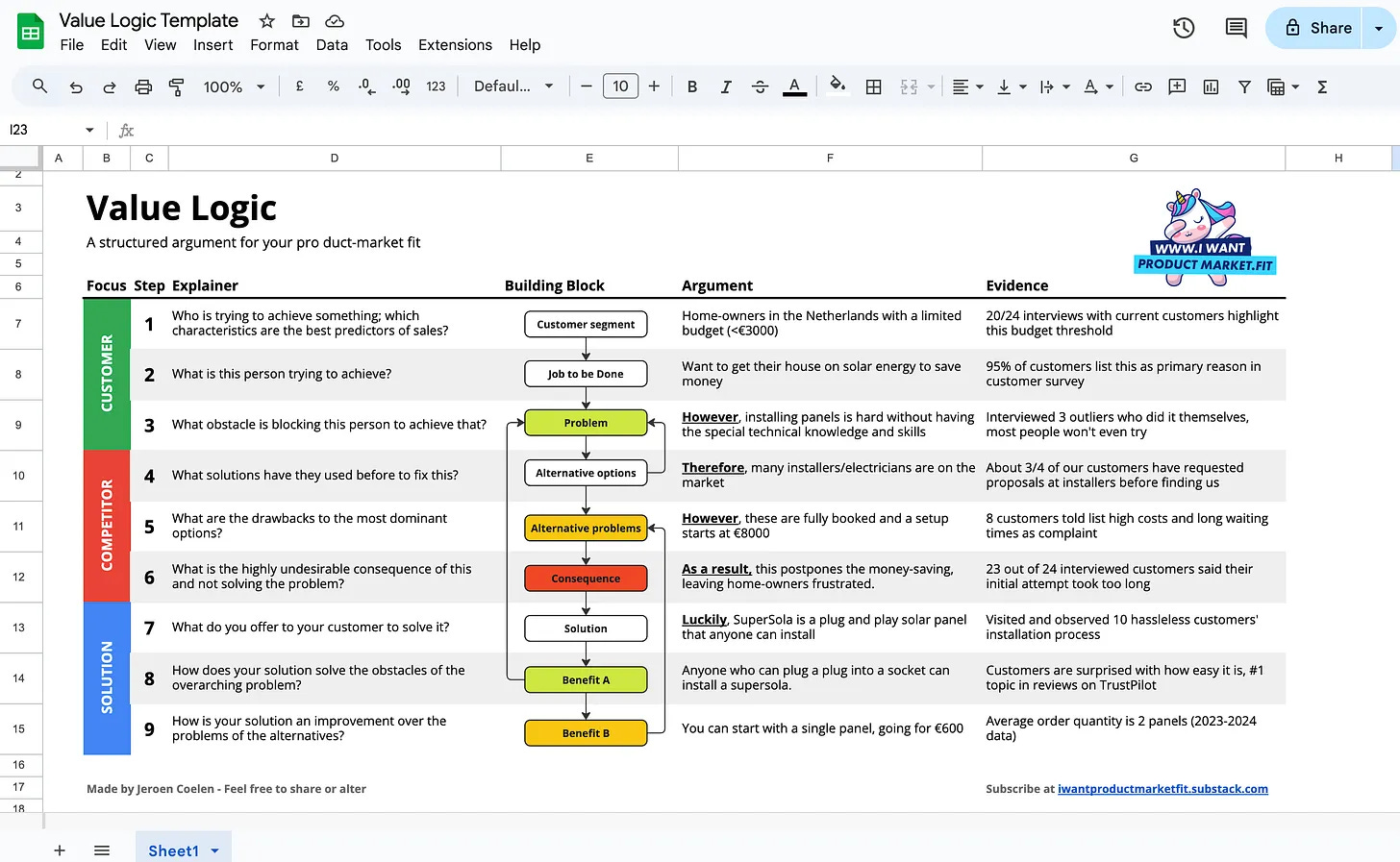Most Founders Struggle to Show Product-Market Fit. This Free Template Makes It Easy
Use this proven PM-Fit Logic framework to craft a compelling narrative, prove your product matters, and raise faster.
Proving product-market fit is essential, and brutally hard. Most founders miss the mark by jumping to the solution too fast.
Most early-stage decks jump into the solution way too fast. Investors are left wondering: Who is this for? What’s the real problem? Why now?
The result? A vague story, a confused audience, and a pass.
That’s why I built the PM-Fit Logic Template: a free, step-by-step framework to help you clarify your value proposition, show market pull, and get investors excited.
It helps with getting your to market strategy laser sharp and identifying your true beachhead.
The template is used in accelerators for pitches and VC fundraising decks.
What Is the Product-Market Fit Logic?
A Product-Market Fit Logic is a structured argument that shows why your product makes perfect sense — not just to you, but to the market.
It breaks down PMF into clear steps:
▫️ Understand your customer
▫️ Map their job to be done
▫️ Frame the problem and alternatives
▫️ Show how your product fits that reality
It helps you shift from vague product pitches to a clear story that proves your solution is the only rational answer to a real, urgent problem.
And that’s what investors actually need to hear.

Why It Works
Most PMF frameworks stay high-level or vague. This one’s different. It forces clarity and logic.
▫️ You define one customer, not a persona soup
▫️ You explain what they’re trying to achieve, not just their “pain points”
▫️ You show what else they use today, and why it’s not good enough
▫️ You don’t mention your product until the end
By the time you do pitch your product, it feels like the obvious next step.
How to Write a PM-Fit Logic (And Make PMF Obvious)
You can’t just say you have product–market fit. You have to prove it — logically, step by step.
The PM-Fit Logic is how you do that. It’s a structured story that shows why your product is the only rational solution to a real, painful, high-priority problem.
To get it right, spend 80% of your time on the problem framing (steps 1–6). Only after that should you mention your own product (steps 7–9). In other words: keep your baby in the bag until you’ve earned the right to talk about it.
Steps 1–3: Know Your Customer
In step 1, 2, and 3 you need to lay out the situation of the customer.
Customer Segment: Who is this, specifically?
Which beachhead customer segment are you talking about?
Make it a real person, so ‘Head of HR’ instead of ‘HR Department’
Job to be done: What is this person trying to achieve?
What is their Job to be Done?
This is not your or your startup’s job to be done!
Problem: What obstacle stands in the way of achieving that Job to be Done?
Understand that a problem and a job is not the same thing.
Steps 4–6: Understand the Competitive Landscape
Here you identify that it’s not a blue ocean, and if your customer doesn’t buy you he does something else.
Dominant Competitors: What is the most dominant solution they use if they are not buying you?
Base this on customer interviews
Competitor Flaws: What are the shortcomings of this solution?
Why does it suck?
Consequence: What happens as a result of the current best option and not fixing the underlying problem?
This must be something people really want to prevent of happening. It should be painful, such as ‘wasting €10k a day’ or ‘employees get fired’
Steps 7–9: Now You Can Talk About Yourself
Only now can you pitch your product, because you’ve made it make sense.
Only now you can start yapping about yourself. But, if you crafted step 1-6 well, your solution should fit like a glove to the problem you just sketched.
Solution: Pitch your solution in 1 sentence.
Explain the product category, what is it that you make
Feature A: Explain how your solution fixes the problem
Make sure your benefit actually tackles the problem of step 3
Feature B: Explain how your solution addresses the shortcomings of alternatives
Make sure that the problem you framed around the shortcomings of the alternatives (step 5) fits really well with this benefit.
Writing Arguments That Actually Work
Anyone can write down crap
Getting any answer to these 9 questions is fairly easy. Getting good answers is harder. Just like anyone can fill in a business model canvas with crap, this canvas can also be filled with useless stuff. The fact that you fill it up doesn’t prove you anything.
Respect the logic
It comes down to being really open and honest about your logic. Check out the words ‘however’, ‘therefore’, which really connect the arguments.
There should be at least two clear fits in this story: between the problem and your benefit A, and the alternatives’ shortcomings and Benefit B. Having both fits is important to articulate your product-market fit.
Make one for each customer segment
Because this product-market fit logic is customer-centric, you can’t pile all potential segments into one pile. You might need to make a version for every customer segment.
Additionally, if you have multiple stakeholders, such as different buyers and users in an organisation, or if you are a two-sided platform, you need to create a value logic for each person.
Writing great evidence
You can’t prove product-market fit without sales
The Value Logic is used to collect the right arguments to get a sense of product-market fit. Completing this exercise doesn’t mean you will get product-market fit. You need to get out there and start selling pilots. Perhaps first free, later paid. Learn more about your next step towards product-market fit.
Bottom-up arguments
You want arguments that are unique to your startup. Things such as ‘this market is growing 60% per year’ are only mildly convincing of product-market fit. Product-market fit requires more than a description of the market. Read more about this.
Quantify when possible
‘Heard in customer interview’ is less convincing than ‘8 out of 10 customers mention this. See the example visual for ways of quantifying evidence. If you can’t quantify, verbatim or slightly paraphrased quotes can really pack a punch!
‘It keeps me up at night’ - Worried HR manager.
Solution evidence
Do you have proof your solution works? If it’s prelaunch, results from a prototype, demo, or a lab test can be great?
🛠️ How to Use the Value Logic Template
Option 1: Use the free Google Sheet
Want the easiest way to get started?
Grab the template as a Google Sheet — pre-structured, colour-coded, and ready to fill in:
Option 2: Use this AI-tool
Enter your answer in this custom GPT and get a 0-100 PM-Fit score. Get detailed feedback on where to improve.

Option 3: Go lo-fi with a whiteboard
Prefer sticky notes and sharpies?
Sketch out the 9 steps on a whiteboard and use post-its to fill in your arguments and evidence.
It’s the same logic, just more tactile, and perfect for team workshops or incubator sessions.
I hope you find it useful!
The VC Corner RESOURCES 🛠️
✅ The SaaS Financial Model that Raised Millions
✅ The Startup MIS Template: A Excel Dashboard to Track Your Key Metrics
✅ The Go-To Pricing Guide for Early-Stage Founders + Toolkit
✅ DCF Valuation Method Template: A Practical Guide for Founders
✅ How Much Are Your Startup Stock Options Really Worth? Startups
✅ How VCs Value Startups: The VC Method + Excel Template
✅ 2,500+ Angel Investors Backing AI & SaaS Startups
✅ Cap Table Mastery: How to Manage Startup Equity from Seed to Series C
✅ 300+ VCs That Accept Cold Pitches — No Warm Intro Needed
✅ 50 Game-Changing AI Agent Startup Ideas for 2025
✅ 144 Family Offices That Cut Pre-Seed Checks
✅ 70+ Startup Pitch Decks That Raised Over $1B in 2024
✅ 89 Best Startup Essays by Top VCs and Founders (Paul Graham, Naval, Altman…)
✅ The Ultimate Startup Data Room Template (VC-Ready & Founder-Proven)
✅ The 100+ Pitch Decks That Raised Over $2B
✅ Ultimate Investor List of Lists (+5k VCs)
✅ 40 Pitch Decks That Raised Over $460M
✅ The Startup Founder’s Guide to Financial Modeling (7 free templates included)
✅ SAFE Note Dilution: How to Calculate & Protect Your Equity (+ Cap Table Template)
✅ 400+ Seed VCs Backing Startups in the US & Europe
✅ The Best 23 Accelerators Worldwide for Rapid Growth (and How to Get Into Them)
✅ The Ultimate Startup & Venture Capital Notion Guide: Knowledge Base & Resources
✅ AI Co-Pilots Every Startup & VC Needs in Their Toolbox









I miss this comfort zone. Now I’m the exception and marketing is reduced to a calculator to translate the value of low value proportion.
Excellent take.. Let's hope tons of founders read this.